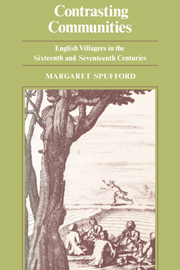Book contents
- Frontmatter
- Contents
- List of maps and graphs
- List of tables
- List of abbreviations
- Acknowledgements
- Dedication
- Introduction
- Map 1 Cambridgeshire: natural boundaries and soil types
- Map 2 Cambridgeshire: county and parish boundaries
- PART 1 People, Families and Land
- PART 2 The Schooling of the Peasantry
- 6 A general view of schools and schoolmasters
- 7 The elementary ability to write: Willingham and Orwell
- 8 The importance of reading in the village community
- PART 3 Parishioners and their Religion
- Conclusion
- Appendix 1 The Butlers of Orwell
- Appendix 2 Notes on Graphs 3 and 5
- Index of Contemporary Names
- General Index
8 - The importance of reading in the village community
Published online by Cambridge University Press: 25 January 2010
- Frontmatter
- Contents
- List of maps and graphs
- List of tables
- List of abbreviations
- Acknowledgements
- Dedication
- Introduction
- Map 1 Cambridgeshire: natural boundaries and soil types
- Map 2 Cambridgeshire: county and parish boundaries
- PART 1 People, Families and Land
- PART 2 The Schooling of the Peasantry
- 6 A general view of schools and schoolmasters
- 7 The elementary ability to write: Willingham and Orwell
- 8 The importance of reading in the village community
- PART 3 Parishioners and their Religion
- Conclusion
- Appendix 1 The Butlers of Orwell
- Appendix 2 Notes on Graphs 3 and 5
- Index of Contemporary Names
- General Index
Summary
However helpful information on the proportion of villagers actually able to sign their names may be, statistics of this sort remain bleak and arid, unless some idea can be gained of the extent to which writing, and more particularly reading, entered into the ordinary life of the village community. Information of this kind can never be complete, and will never be capable of expression in statistical terms. It must necessarily be fragmentary and impressionistic. J. W. Adamson collected such information for the fifteenth and early sixteenth centuries, and showed, for instance, that ‘Englische billes’ were placed on the Norwich city gates in 1424. They were presumably intended to be read not only by the urban inhabitants but by country folk coming into market. By 1534, girls in Langham village on the borders of Essex and Suffolk could read Matins in English. The number of devotional works, from Richard Whitford's A Werke for Householders printed in 1530, to Josias Nicholas's Order of Household Instruction which appeared in 1596, argues a market for such works, although we do not know how far it was an urban market. We do know that in the 1530s and 1540s reformers had an active policy of reprinting and distributing Lollard books.
The episcopate had an interest in disseminating orthodox theological literature in every parish, in the sixteenth century, quite apart from Cranmer's general argument, that the Scriptures ought to be read by all sorts and kinds of people and in the vulgar tongue.
- Type
- Chapter
- Information
- Contrasting CommunitiesEnglish Villages in the Sixteenth and Seventeenth Centuries, pp. 206 - 218Publisher: Cambridge University PressPrint publication year: 1974



